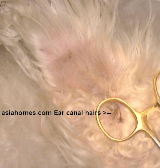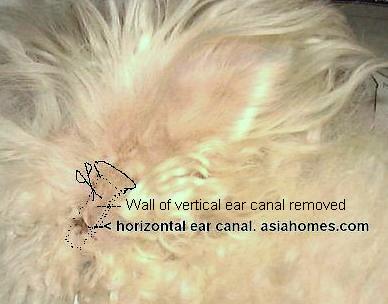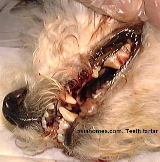1104Singapore
Bichon Frise aural resection, otitis externa, smelly ears, excessive amount of ear
hairs, pet health and welfare educational for animal lovers, excerpts from The Glamorous Vets,
Singapore, sponsored by AsiaHomes Internet.
The Bichon Frise had vinegar-smelly ears.
" My Bichon has a strong
acidic smell two days after bathing. It keeps scratching its ears and shaking head
many times a day," said Ms Lim, a slim and busy career lady who worked hard and
travel regionally and could barely spare some time to bring her dog to the vet. "How
do I get rid of this smell?" My Bichon has a strong
acidic smell two days after bathing. It keeps scratching its ears and shaking head
many times a day," said Ms Lim, a slim and busy career lady who worked hard and
travel regionally and could barely spare some time to bring her dog to the vet. "How
do I get rid of this smell?"
Smelly ears are a common complaint of some floppy eared dogs like poodles and
spaniels.
"Your Bichon has an excessive amount of ear hairs inside both ears. The
wiry hairs clog up
the ear canal and accumulates moisture. The bacteria loved the dampness and multiplied to
produce a vinegar-like smell and infection called otitis externa." I said.
"I use a blue ear wash bought from the pet shop but it did not help," said Ms
Lim. The wash could not eliminate this odour.
"Unlike human beings who have only a horizontal ear canal, the dog has a L-shaped ear
canal comprising a vertical canal and a horizontal canal. The ear opening you see is the entry to the vertical canal
which curves inwards to form the horizontal canal".
It was hard for Ms Lim to figure out what I was saying. I took out a model of the L-shaped ears using two syringes joined together to
represent the dog's ears. It gave some idea. I showed her a photograph
of the anatomy of the dog's ear canals.  "Your photograph of
the Cocker Spaniel was helpful in
explaining the anatomy of the dog's ear canals," Ms Lim commented, looking at her
watch as she had to go for another appointment. "What is the cure and how much it
would cost me?" asked Ms Lim. "Your photograph of
the Cocker Spaniel was helpful in
explaining the anatomy of the dog's ear canals," Ms Lim commented, looking at her
watch as she had to go for another appointment. "What is the cure and how much it
would cost me?" asked Ms Lim.
"There are two options - regular ear hair plucking or surgery to open up the vertical
ear canal, " I said. "The vet or the owner can pluck off the ear hairs every
three months and irrigate the ear canals. A forceps clamps onto the ear hairs which
are twisted and pulled out fast. The groomer could do this too and you will find that many
Singapore groomers use the fragrant ear powder to clean up the ears."
"It must be very painful for the dog," Ms Lim imagined.
"Many dogs will run away when they see the forceps," I said. The poor dogs
must know they are going to be tortured.
"How much it will cost to do surgery and how effective it will be?" Ms Lim
asked.
"The cost will be $150 per ear, inclusive of anaesthesia. It is generally very
effective as the ventilation of the ear is much better when the vertical canal wall is
opened up."
"That is too expensive," Mrs Lim, the mother said. "There
are so many people starving in this world. The money would be of more use
to human beings." Since Mrs Lim had lived through World War Two, she
knew about the hunger and deprivations. There was no money worth spending
on dogs when priority should be given to alleviate human hunger. "We
should go to the government animal infirmary," Mrs Lim suggested.
"Unless you give us a discount."
Bargaining was a way of life for Mrs Lim.
"Since the Bichon is only two years old, it will have no more ear problems for the next
15 - 20 years of life. It will not need the regular ear hair pulling and ear canal
irrigation for the next ten years and savings are considerable. It
can be as much as $900 spread over ten years." I said., assuming the
dog gets regular grooming twice a year.
However, a veterinary fee of $300 for anaesthesia and operation of two ears sounded like a lot of money in
the 1970s.
It was one third of the monthly salary of a new graduate working in Singapore the civil
service.
"Why not get regular ear cleaning?" Groomer Ken proposed. It would be more
revenue generating not to recommend surgery, assuming the Bichon would be
regularly groomed.
Ms Lim made her decision to get the operation done.

The dog was put under general
anaesthesia and half of the outer wall of the vertical canal was removed as
shown by the dotted lines in the picture above. The rectangular piece of
cartilage and skin (dotted rectangle in the picture above) was cut
off. The sides of the canal were stitched up. A small piece of
cartilage on the lower part was anchored below the opening of the
horizontal canal to serve as a drainage board.

When the wounds healed and the stitches were removed, you could can see an opening.
This is the entrance to the horizontal canal. Now, the profuse growth of ear canal hairs on the
inner side of the vertical canal could grow as much as they like as there
would not be a problem of smelly ears. The vertical canal was open and
there would be ventilation of the ear canal, preventing the growth of
bacteria and fungus. The opening of the horizontal canal cannot be
seen when the ear flap flops down over the head.
|
 My Bichon has a strong
acidic smell two days after bathing. It keeps scratching its ears and shaking head
many times a day," said Ms Lim, a slim and busy career lady who worked hard and
travel regionally and could barely spare some time to bring her dog to the vet. "How
do I get rid of this smell?"
My Bichon has a strong
acidic smell two days after bathing. It keeps scratching its ears and shaking head
many times a day," said Ms Lim, a slim and busy career lady who worked hard and
travel regionally and could barely spare some time to bring her dog to the vet. "How
do I get rid of this smell?" 



